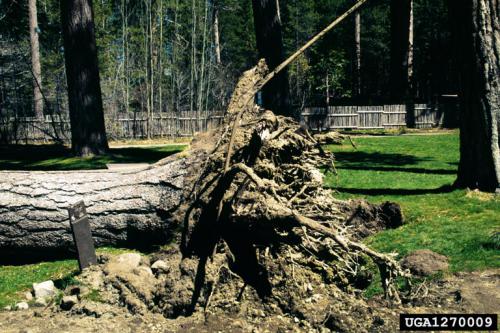Protect tree roots from soil compaction
Soil compaction can damage delicate root systems in invisible ways.

Summer festivals and fall tailgates can be crowd pleasers that bring many people together around our green spaces. In many locations, visitors may spy signs or other directions that request avoiding parking on ground near or around mature trees. Keeping heavy machinery, including cars, off of grounds with trees is an important way to avoid soil compaction and protect tree root systems. In some more sensitive areas, even excessive and extensive foot traffic can cause potential harm.
Basic tree physiology explains why this is an important concern. Tree roots serve several critical functions: collection and transport of water and nutrients (essential to photosynthesis), energy (sugar) storage and tree stabilization (anchoring). The larger roots of a tree are more important for basic transport, storage and anchoring. On the other hand, the tinier, hair-like roots are essential for water and nutrient uptake. Because of this central function, they are called “feeder roots”. Feeder roots are also often paired with symbiotic fungi, called mycorrhizae. These fungi integrate themselves with the roots, expanding their surface area and offering more potential for water and nutrient uptake. They also protect the tree from pathogens. For many tree species, the presence of mycorrhizae is critical to overall tree health. The majority of these root systems are located in the upper 18-24 inches of soil to take advantage of as much rain or melting snow, nutrients and oxygen as possible.
How far from a tree do these roots extend? Conventional wisdom suggests root systems are a “mirror image” of the tree’s crown, where the roots can reach a distance that equals the outermost branches—often called the drip line. In actuality, this usually underestimates the extent of a tree’s root system. Depending on soil conditions and a tree’s freedom to grow, roots can extend two or more times farther than the total height of the tree.
Because soil compaction is not something we can easily see, its harmful effects may not be easy to observe. Compacted soils reduce water availability in two ways: reduced water holding capacity and increased runoff. A tree’s roots will then have less access to that water, resulting in less water uptake to the leaves for sugar manufacture via photosynthesis. Additionally, compacted soils also reduce oxygen availability, which is another requirement for healthy root—and mycorrhizal—development and maintenance. This loss of water, nutrient and oxygen access can cause tree crown dieback or even death of the entire tree. Compaction can also affect its physical stability. As tree root systems suffocate, a tree’s ability to anchor itself is compromised. Such trees are more susceptible to being knocked over during major storms or other disturbances.

Soil compaction can lead to catastrophic storm damage. | Photo by: John Pronos, USDA Forest Service
Treading carefully around vulnerable root systems is a critical way to keep trees healthy and intact. Avoid parking vehicles on non-paved surfaces and leave plenty of room for trees during major construction projects.
For an entertaining way to learn more about how a tree functions, view the How a Tree Works video, created jointly by the Michigan Forest Association and Michigan State University Extension.



 Print
Print Email
Email



